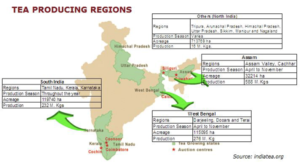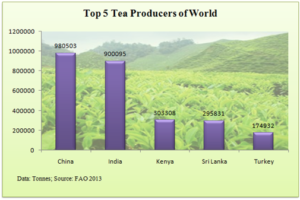India’s tea industry needs policy liberalization for rejuvenation.
Relevance:
- GS Paper – 2, GS Paper – 3 Growth & Development, Distribution of Key Natural Resources, Agricultural Resources, Cropping Patterns.
- Tags: #Tea industry, #Darjeeling Tea, #Tea Board of India, #One District and One Product
Why in the news?
- India is the 2nd largest tea producer and largest black tea producer after China and 4th largest exporter of Tea in the world.
- India is also the largest consumer of black tea and accounts for 18% of the total World tea consumption.
- The main tea-growing regions are in the Northeast (including Assam) and in north Bengal (Darjeeling district and the Dooars region).
- Tea is also grown on a large scale in the Nilgiris in south India.
Ideal climate condition for tea cultivation
- Originate in tropical and subtropical climates.
- Major tea growing regions are mainly concentrated in Asia, Africa, South America.
- Tea requires cool to warm temperatures with at least 5 hours of sunlight per day.
- The average annual temperature for tea plants to grow well is in the range of 15 – 23°C.
- The rainfall needed is between 150-200 cm.
Market Size of Tea Industry in India
- In 2020, nearly 10 million tons of tea was consumed in the country.
- The market in the country is projected to witness a further growth in the forecast period of 2022-2027, growing at a CAGR of 4.2%.
- In 2026, the tea industry in India is expected to attain 1.40 million tons.
Tag for Geographical Indication (GI)
- The first GI tag product was Darjeeling Tea, also known as the “Champagne of teas” due to its floral aroma.
- Green and white tea, the other two Darjeeling tea varieties, also have GI tags.
- The Indian tea industry is being developed and promoted by the Tea Board of India.
About Tea Board of India
- The genesis of the Tea Board India dates back to 1903 when the Indian Tea Cess Bill was passed.
- The present Tea Board was set up under Section 4 of the Tea Act 1953.
- It is functioning as a statutory body of the Central Government under the Ministry of Commerce.
- Members: They are drawn from Members of Parliament, tea producers, tea traders, tea brokers, consumers, and representatives of Governments from the principal tea producing states, and trade unions.
HQ: Kolkata
- The Board is reconstituted every three years.
- Earlier, the Tea Board had offices in Cairo and Kuwait.
- But these two offices were relocated to Dubai.
Issues associated with the Indian Tea sector
- Stiff competition and improved standards in the world market – due to low product prices from Kenya and other countries – increasing demand for organic tea and quality assurance that entails environmental justice.
- Decline in productivity and quality – Tea bushes must be replanted every five years, but most Tea bushes older than 20 yrs.; uneven rainfall due to climate change – is affecting the productivity and quality of Indian Tea leading to lower prices at Tea auctions.
- Poor worker conditions and low wages – despite the provisions of the Plantation Labor Act, 1951 most workers and their families live in unsanitary conditions and receive low wages – this issue needs to be addressed given the fact that “starvation deaths” in North Bengal caught the international media attention.
- Small Tea Growers – the challenges faced by the Small Tea Growers’ sector is as follows-
-
- Not getting the right green leaf price.
- Unlike large estates, STG’s are not able to capitalize on scale and marketing of product as a collective is difficult – since it is unorganized.
- Issue of workers’ rights – since STG’s are not governed by the PLA, 1951.
Most of them are not recognized by the Tea Board of India due to landownership regulations and related procedural problems – this means lesser data available on the state of the STG’s making it difficult for policy coordination
- Some global factors like the decline in demand from European markets in the wake of the Russia-Ukraine war have compounded the problem.
Suggestive measures
- The One District and One Product (ODOP) program can aid in promoting Indian Tea’s fame.
- The “AROMA” of tea needs to be improved in order for the industry to become profitable, viable, and sustainable.
- Support small farmers to raise production to satisfy domestic and international demand while improving quality and sustainability.
- Create infrastructure to boost exports and concentrate on high value markets like the EU, Canada, South America, and the Middle East to re-energize.
- Promote GI tea and organic tea using brand marketing and promotion.
Modernization: To help local supply networks be strengthened and tea producers to become self-sufficient
Adaptability: Focus on the importance of a risk proof ecosystem, that is, the need for sustainable solutions to make tea plantations meet the challenges of climate change.
Way Forward
India being the second largest producer of Tea has numerous opportunities to develop the Tea Industry as it is providing employment to a huge number of people in the north eastern states. A win-win for all and therefore a truly sustainable and transparent model — is the key requirement for a highly labor-centric industry like tea plantations.
Source: Livemint.
Mains Question
Whereas the British planters had developed tea gardens all along the Shivaliks and Lesser Himalayas from Assam to Himachal Pradesh, but they did not succeed beyond the Darjeeling area. Explain





